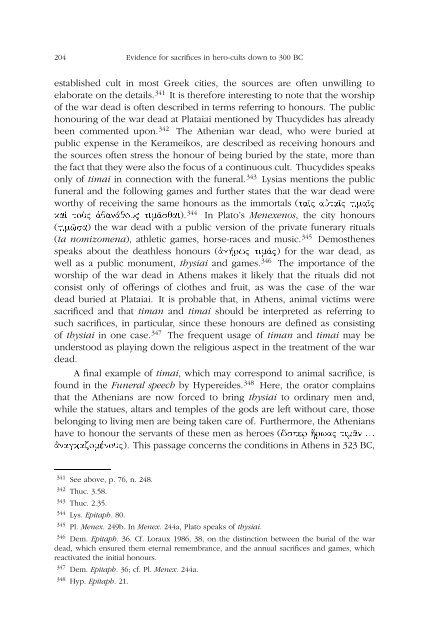The sacrificial rituals of Greek hero cults in the Archaic to the early ...
The sacrificial rituals of Greek hero cults in the Archaic to the early ...
The sacrificial rituals of Greek hero cults in the Archaic to the early ...
You also want an ePaper? Increase the reach of your titles
YUMPU automatically turns print PDFs into web optimized ePapers that Google loves.
204 Evidence for sacrifices <strong>in</strong> <strong>hero</strong>-<strong>cults</strong> down <strong>to</strong> 300 BC<br />
established cult <strong>in</strong> most <strong>Greek</strong> cities, <strong>the</strong> sources are <strong>of</strong>ten unwill<strong>in</strong>g <strong>to</strong><br />
elaborate on <strong>the</strong> details. 341 It is <strong>the</strong>refore <strong>in</strong>terest<strong>in</strong>g <strong>to</strong> note that <strong>the</strong> worship<br />
<strong>of</strong> <strong>the</strong> war dead is <strong>of</strong>ten described <strong>in</strong> terms referr<strong>in</strong>g <strong>to</strong> honours. <strong>The</strong> public<br />
honour<strong>in</strong>g <strong>of</strong> <strong>the</strong> war dead at Plataiai mentioned by Thucydides has already<br />
been commented upon. 342 <strong>The</strong> A<strong>the</strong>nian war dead, who were buried at<br />
public expense <strong>in</strong> <strong>the</strong> Kerameikos, are described as receiv<strong>in</strong>g honours and<br />
<strong>the</strong> sources <strong>of</strong>ten stress <strong>the</strong> honour <strong>of</strong> be<strong>in</strong>g buried by <strong>the</strong> state, more than<br />
<strong>the</strong> fact that <strong>the</strong>y were also <strong>the</strong> focus <strong>of</strong> a cont<strong>in</strong>uous cult. Thucydides speaks<br />
only <strong>of</strong> timai <strong>in</strong> connection with <strong>the</strong> funeral. 343 Lysias mentions <strong>the</strong> public<br />
funeral and <strong>the</strong> follow<strong>in</strong>g games and fur<strong>the</strong>r states that <strong>the</strong> war dead were<br />
worthy <strong>of</strong> receiv<strong>in</strong>g <strong>the</strong> same honours as <strong>the</strong> immortals (taîv a¹taîv timaîv<br />
kaì <strong>to</strong>ùv janájouv timâsjai). 344 In Pla<strong>to</strong>’s Menexenos, <strong>the</strong> city honours<br />
(tim÷sa) <strong>the</strong> war dead with a public version <strong>of</strong> <strong>the</strong> private funerary <strong>rituals</strong><br />
(ta nomizomena), athletic games, horse-races and music. 345 Demos<strong>the</strong>nes<br />
speaks about <strong>the</strong> deathless honours ( gårwv timáv) for <strong>the</strong> war dead, as<br />
well as a public monument, thysiai and games. 346 <strong>The</strong> importance <strong>of</strong> <strong>the</strong><br />
worship <strong>of</strong> <strong>the</strong> war dead <strong>in</strong> A<strong>the</strong>ns makes it likely that <strong>the</strong> <strong>rituals</strong> did not<br />
consist only <strong>of</strong> o�fer<strong>in</strong>gs <strong>of</strong> clo<strong>the</strong>s and fruit, as was <strong>the</strong> case <strong>of</strong> <strong>the</strong> war<br />
dead buried at Plataiai. It is probable that, <strong>in</strong> A<strong>the</strong>ns, animal victims were<br />
sacrificed and that timan and timai should be <strong>in</strong>terpreted as referr<strong>in</strong>g <strong>to</strong><br />
such sacrifices, <strong>in</strong> particular, s<strong>in</strong>ce <strong>the</strong>se honours are def<strong>in</strong>ed as consist<strong>in</strong>g<br />
<strong>of</strong> thysiai <strong>in</strong> one case. 347 <strong>The</strong> frequent usage <strong>of</strong> timan and timai may be<br />
unders<strong>to</strong>od as play<strong>in</strong>g down <strong>the</strong> religious aspect <strong>in</strong> <strong>the</strong> treatment <strong>of</strong> <strong>the</strong> war<br />
dead.<br />
A f<strong>in</strong>al example <strong>of</strong> timai, which may correspond <strong>to</strong> animal sacrifice, is<br />
found <strong>in</strong> <strong>the</strong> Funeral speech by Hypereides. 348 Here, <strong>the</strong> ora<strong>to</strong>r compla<strong>in</strong>s<br />
that <strong>the</strong> A<strong>the</strong>nians are now forced <strong>to</strong> br<strong>in</strong>g thysiai <strong>to</strong> ord<strong>in</strong>ary men and,<br />
while <strong>the</strong> statues, altars and temples <strong>of</strong> <strong>the</strong> gods are left without care, those<br />
belong<strong>in</strong>g <strong>to</strong> liv<strong>in</strong>g men are be<strong>in</strong>g taken care <strong>of</strong>. Fur<strong>the</strong>rmore, <strong>the</strong> A<strong>the</strong>nians<br />
have <strong>to</strong> honour <strong>the</strong> servants <strong>of</strong> <strong>the</strong>se men as <strong>hero</strong>es (¢sper rwavtimân...<br />
nagkazoménouv). This passage concerns <strong>the</strong> conditions <strong>in</strong> A<strong>the</strong>ns <strong>in</strong> 323 BC,<br />
341 See above, p. 76, n. 248.<br />
342 Thuc. 3.58.<br />
343 Thuc. 2.35.<br />
344 Lys. Epitaph. 80.<br />
345 Pl. Menex. 249b. In Menex. 244a, Pla<strong>to</strong> speaks <strong>of</strong> thysiai.<br />
346 Dem. Epitaph. 36. Cf. Loraux 1986, 38, on <strong>the</strong> dist<strong>in</strong>ction between <strong>the</strong> burial <strong>of</strong> <strong>the</strong> war<br />
dead, which ensured <strong>the</strong>m eternal remembrance, and <strong>the</strong> annual sacrifices and games, which<br />
reactivated <strong>the</strong> <strong>in</strong>itial honours.<br />
347 Dem. Epitaph. 36; cf. Pl. Menex. 244a.<br />
348 Hyp. Epitaph. 21.



